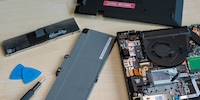
Background information
"Framework is my goal": the dream of the modular ThinkPad
by Jan Johannsen
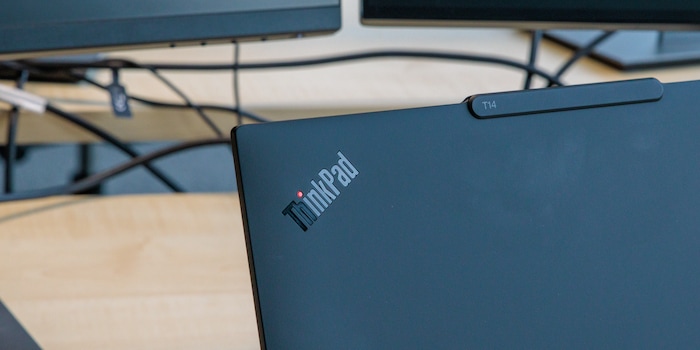
This notebook is a dream for anyone who wants to replace or repair components themselves - but it's still just the beginning.
Lenovo has teamed up with the repair experts from iFixit for the Thinkpad T14 Gen 5. They were actively involved in the development of the notebook and provide instructions and spare parts. I take a look at what they have come up with for the simple replacement of the components.
However, the notebook is only the first step. Christoph Blindenbacher from Lenovo already knows what will soon be even easier to repair and has a big vision.
To open the Thinkpad T14, I have to turn it over. I can see five Phillips screws on the underside. I can loosen them with a standard screwdriver. Nevertheless, I can't get the keyboard or the underside off as promised.
I hope the instructions will help. However, the QR code on the underside only takes me to the notebook's general page. After a bit of searching, I find the information I need in a PDF file. The most important finding: There are six screws. However, one is hidden under the "Seal Sticker - DO NOT REMOVE" sticker. With a bit of fumbling, I find the screws under the sticker. I accept its destruction in order to unscrew it.
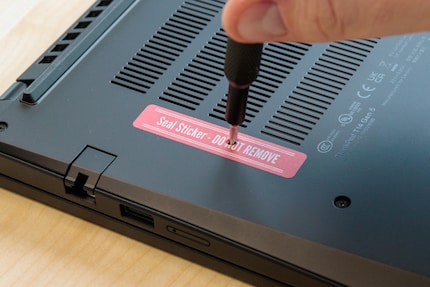
This hidden screw is one of the two I have to loosen to replace the keyboard. In theory, I should be able to push it up slightly and then lift it. In practice, however, I have to rely on the "opening picks" from my iFixit tool set. I can't get it off with my hands alone. Once the keyboard is out, I have to loosen a plug connection to install a new keyboard. Unlike removal, this works without tools.
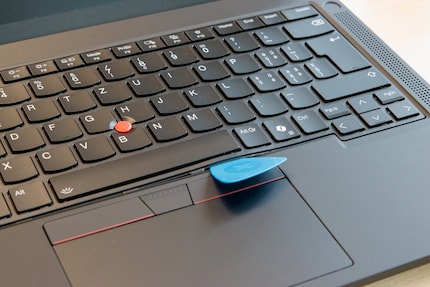
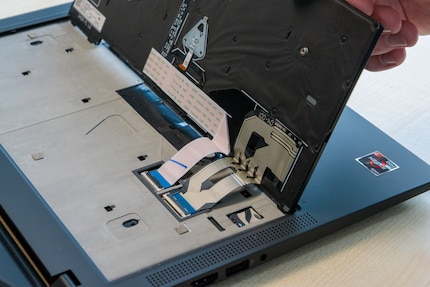
I only need a screwdriver to remove the underside of the Thinkpad T14. Once all the screws have been loosened, my fingernails are enough to hook underneath the lid hinges and remove the cover without any problems.
On the plus side, I notice that the six screws are fixed in the thread. So they stay in the cover and don't get lost.
Lenovo has labelled the components that I as a user can replace without affecting the warranty and the like: SSD, DIMM 1 and 2 and the wireless module (WWAN). The battery is not labelled separately, but is clearly recognisable.
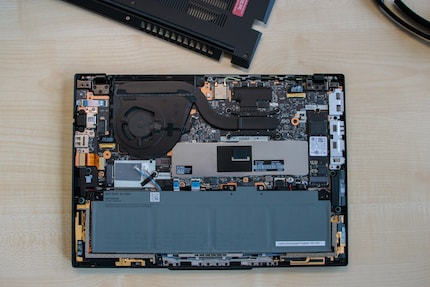
When looking for instructions, I only find what I'm looking for on the battery. The printed QR code takes me to a collection of helpful documents on the T14 Gen 5. I have to click again in the left-hand column for the spare parts. There are no QR codes on the other replaceable components. Since they are also used in other notebooks, Lenovo says that such a label would make spare parts storage much more complex. However, they are currently working on a solution to improve this even further.
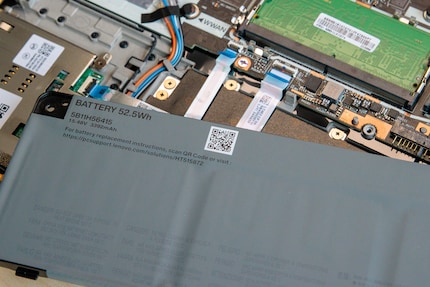
I would like to see instructions in the style of Ikea. iFixit doesn't have them yet either. The page for the Thinkpad T14 Gen 5 is still a yawning void. I only get confirmation that it is very easy to repair with 9/10 points - and could create a manual myself.
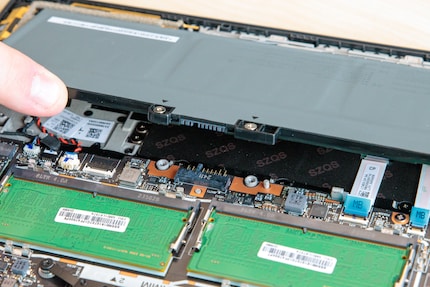
Then I dare to use my knowledge to build the components myself. I recognise two screws on the accumulator that I still have to loosen. It is also held in place by two screws on the housing cover. Once the screws - which are also anchored in the thread - have been loosened, I manage to remove the battery with careful movements. Its plug connection to the mainboard is insensitive and uncomplicated for me as a user.
The SSD - a single M.2 2280 - is fixed in place with a screw. I can loosen it quickly. Afterwards, however, I would like to have a short guide that tells me where to start to loosen the SSD: Lift slightly at the end of the screw, don't get irritated by the "rubber mat" underneath it and then carefully pull it out. Once you know this, it's easy to insert afterwards.
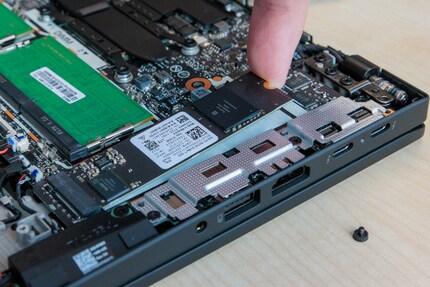
Continue to the memory. The two latches are located under a silver cover, which I lift using a tab. I would also like a brief instruction manual here. However, with a little trial and error and remembering how other RAM bars are attached, I find the mechanism: Push the silver brackets on the right and left a little to the side. The latches then pop up and can be removed. After inserting new latches, all you have to do is push them down and put the silver cover back over them.
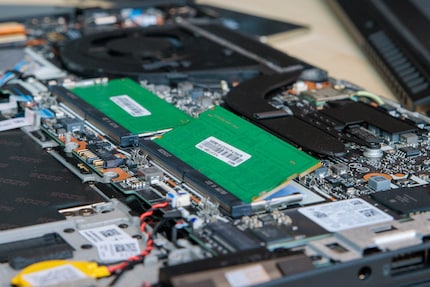
The screw for the mobile radio module is clearly labelled "WWAN", but I wouldn't dare go near it without instructions. The same applies to a number of other screws that I see, but according to Lenovo, these are primarily intended to make work easier for trained service personnel and are not intended for home use. These are, for example, the screws for the touchpad, which are no longer hidden under the mainboard, but only under the battery.
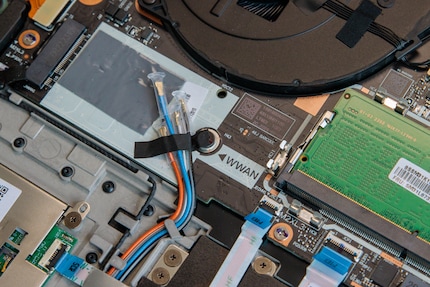
I can easily access the components intended for replacement. The keyboard and battery are the two components that customers most frequently want to replace, according to Lenovo. However, I lack instructions and ordering options for spare parts. Both were promised and would make repairs easier for non-experts.
My Thinkpad T14 Gen 5 test device has an anti-glare, 14-inch IPS display. With an aspect ratio of 16:10, it is not quite as narrow as models with 16:9 displays, which I find more comfortable for employees. The resolution of 1920 × 1200 pixels ensures a sharp display and as the notebook is not intended for gaming, the refresh rate of 60 Hertz is fine. Lenovo also offers a version of the T14 with an OLED display and higher resolution.
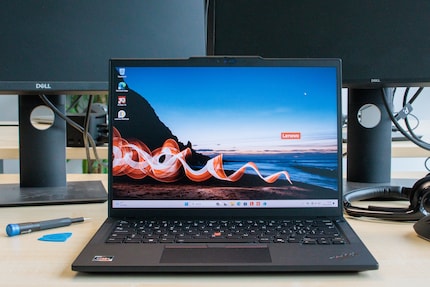
Lenovo specifies the display brightness of my test device at 400 nits, which corresponds to the current standard. I even measured just over 450 nits at the peak. This is easily sufficient for indoor use. However, if you are dependent on a large colour space coverage, you should opt for a different display. According to multiple measurements, it is only 59 per cent for sRGB - and Lenovo claims 100 per cent. For DCI-P3 and Adobe RGB, it is also a measly 42.5 and 41.8 per cent respectively.
For me, the Thinkpad T14 Gen 5 is all about repairability. Accordingly, I will be brief in my assessment of the performance. The Thinkpad is also available in countless configurations. There are eight different processors from AMD and Intel to choose from. There are also three variants each of storage space and RAM. There are currently 25 models in Switzerland and 12 notebooks in Germany, as 13 devices with a Swiss keyboard are missing.
The following performance values only apply to the ThinkPad T14 Gen 5 with the AMD Ryzen 7 8840U - including integrated Radeon 780M graphics chip - and 16 gigabytes of RAM. The notebook with this processor is currently only available from us with 32 gigabytes and a CH keyboard.
As a comparison, I choose the Huawei Matebook X Pro (2024) with the Intel Core Ultra 9 185H, which matches the AMD Ryzen 7 8840U in terms of time, but is slightly higher-end. The AMD Ryzen AI 9 HX 370 of the Asus Zenbook S 16, on the other hand, is from a newer chip generation.
With its CPU and GPU, the Thinkpad T14 is well equipped for office work. Video calls, complex Excel files and simple image editing are no problem. However, if you are constantly dealing with large files or amounts of data, you will have shorter waiting times with other chipsets.
Especially when multiple computing cores are required, Geekbench and Cinebench measure between 18 and 39 per cent more performance for the Core Ultra 9 and the Ryzen AI 9. In single-core mode, however, the maximum increase is 10 per cent. In Geekbench, the Intel chip performs even worse than the AMD in the ThinkPad.
When it comes to graphics performance, the Radeon 780M graphics chip lags behind the integrated chips of the other processors. The Intel Arc and the AMD Radeon 890M perform between 9 and 42 per cent better, depending on the graphics interface.
PCMark 10 simulates various office tasks and uses the entire computer. I mainly look at the sub-values for productivity (spreadsheets and writing) and digital content (photo editing, rendering and visualisation as well as video editing). This shows that the Thinkpad is a powerful office computer that only lags behind slightly when it comes to creating and editing content.
When it comes to connections, the Thinkpad offers more than the average notebook as a business device. It has two USB-A and two Thunderbolt 4 ports (USB-C). There is also HDMI 2.1 and a LAN socket for the network cable with
1 Gbit/s. The smart card reader and SIM slot round off the range. Wirelessly, the Thinkpad T14 offers Bluetooth 5.3 and Wi-Fi 6.
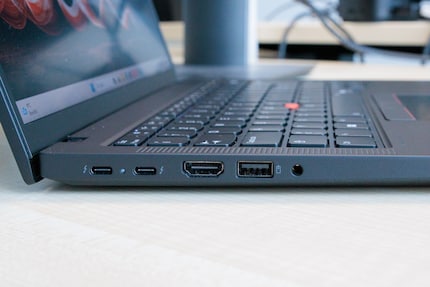
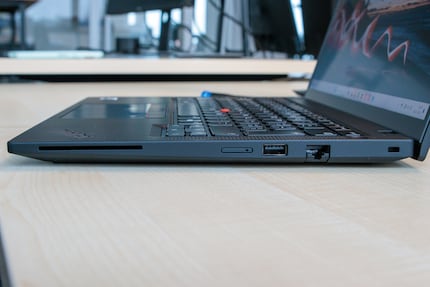
In comparison with the Matebook X Pro and the Zenbook S 16, the Thinkpad T14 Gen 5 has a significantly shorter battery life. PCMark's "Modern Office" battery test shows a difference of over three and a half hours. At 7:13 hours, the performance of the Lenovo notebook's removable battery is not enough for a full working day.
However, on closer inspection, the Thinkpad's battery is not so bad, but above all smaller. It has a capacity of 52.5 watt hours (Wh). The laptops from Asus and Huawei both have 78 Wh. That's almost 50 per cent more - which roughly corresponds to the additional runtime.
According to Lenovo, the battery charges to 80 per cent of its capacity in 60 minutes using a standard 65-watt power supply unit.
The Thinkpad T14 Gen 5 scores many points for its repairability. The keyboard, battery, RAM and SSD can be replaced with minimal knowledge and few tools. However, I would like to see instructions that are easier to find so that even newcomers can get started.
Apart from the easy replacement of a few components, the Thinkpad T14 Gen 5 is a typical office notebook with enough power for everyday office work. However, I wouldn't use it for graphics work where colours are important due to the low colour space coverage - and the computing power is also not ideal for rendering large files.
The battery is small and doesn't have the longest runtime. It won't last an 8-hour day without recharging. The many ports, keyboard and touchpad are positive features. The red cursor button typical of ThinkPads and the two buttons above the touchpad are very pleasant after a short period of familiarisation.
Pro
Contra
As a primary school pupil, I used to sit in a friend's living room with many of my classmates to play the Super NES. Now I get my hands on the latest technology and test it for you. In recent years at Curved, Computer Bild and Netzwelt, now at Digitec and Galaxus.